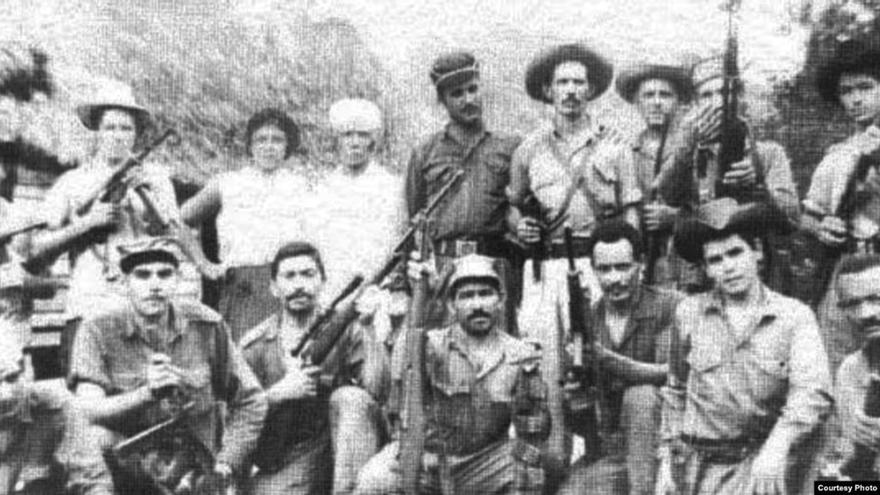
![]() 14ymedio, Pedro Corzo, Miami, 16 April 2023 — This is not an opinion article, but rather a chronicle that intends to offer a close account of the 60th anniversary of the bloodiest year in the fight against Castro’s totalitarianism. So fierce was the year of 1963 that everyone calls it the “year of the lash*.”
14ymedio, Pedro Corzo, Miami, 16 April 2023 — This is not an opinion article, but rather a chronicle that intends to offer a close account of the 60th anniversary of the bloodiest year in the fight against Castro’s totalitarianism. So fierce was the year of 1963 that everyone calls it the “year of the lash*.”
It was during the commemoration of the 56th anniversary of the closure of the Isle of Pines political prison, organized by the Institute of Cuban Historical Memory against Totalitarianism under the leadership of Ramiro Gómez, that it occurred to Enrique Ruano to remember the bloodiest year of our republican history.
Sixty years ago some of the bloodiest combats took place in our plains and mountains as well as several of the mass executions sponsored by Castroism.
On January 3, guerrilla captain Porfirio Guillen fell, along with ten other men, in the vicinity of the Manicaragua cemetery, one day after Enrique Ruano himself brought him supplies necessary for the war.
On February 23, a militiaman murdered four young men at the La Perla hotel in Sancti Spíritus. On March 1, the second chief of the Escambray, Tomas David San Gil, fell in combat at the Monte de las Cuarenta Caballerías [Mount of the 40 Cavalries ], also known as Las Llanadas de Gómez, along with twelve of his men; an exceptional young man who would have contributed a lot to Cuba.
That same month, on the 21st, in a place known as El Algarrobo, in Escambray, a confrontation took place between the guerrillas commanded by Captain Ramón del Sol with the militias and the Army; six insurgents died there. The next day, near the Limonares sugar mill, in Matanzas, the guerrilla captain Juan José (Pichi) Cátala was mortally wounded, along with a brother and four other guerrillas. In El Guayabo, Camagüey, the forces of the guerrilla chief Juan Alberto Martínez Andrade , were attacked resulting in the death of four of their men.
On May 18, the guerrilla leader, Pedro Perico Sánchez, who had already lost two of his sons in combat the previous month, fell. Eight days later, near Encrucijada, the guerrilla leader Domingo González García, Mingo Melena, died with a dozen of his men. According to information from eyewitnesses, the wounded were finished off by the militias.
On June 20, in a confrontation with the militias and the Army in Las Piedras, near Aguada de Pasajeros, guerrilla captain Esteban Morales was killed along with six of his men, four of whom have never been identified.
June 11 and 13, 21 men are massacred in Manacas Izaga, Trinidad, after spending almost two years in the Isla de Pinos prison without trial or sentence, 23 were to be shot; one of the survivors, Aldo Chaviano, is living testimony of that massacre.
On August 15, a guerrilla commanded by Maro Borges faced several militia battalions and the Lucha contra Bandidos / LCB (Struggle Against Bandits), in Guácima, Escambray; the guerrillas lost 11 men and several wounded, including Raúl García, El Quechole.
The regime continued to deploy thousands of fully armed troops and with the support of helicopters in all the areas where uprisings were operating, motivating bloody combats such as the one in Laguna de Taje, near Trinidad, Las Villas, where the guerrilla leader Pedro González, together with his brother and seven other men lost their lives. The mortal remains of Pedro González and his lieutenant, Guillermo Torres, were transported to the Trinidad park and thrown on the pavement, where they were vilely abused by the mob summoned by the LCB troops and State Security.
December 19, one of the bloodiest combats in the entire history of guerrilla struggles in republican Cuba takes place. In some sugar cane fields near the Portugalete sugar mill, in Palmira, south of Las Villas, the guerrilla leader Luis Molina died, and the guerrilla leader Antonio Otero, along with 6 other guerrillas.
That was the Year of the Lash, and here there are not the confrontations resulting in two or three deaths, nor the almost daily executions, nor the armed incursions that came from abroad. I paraphrase an expression of our director and friend, Pepe Bello: “Who says that the Cubans did not fight against totalitarianism?”
*Translator’s note: See here for the prior Year of the Lash in 1844
____________
COLLABORATE WITH OUR WORK: The 14ymedio team is committed to practicing serious journalism that reflects Cuba’s reality in all its depth. Thank you for joining us on this long journey. We invite you to continue supporting us by becoming a member of 14ymedio now. Together we can continue transforming journalism in Cuba.
